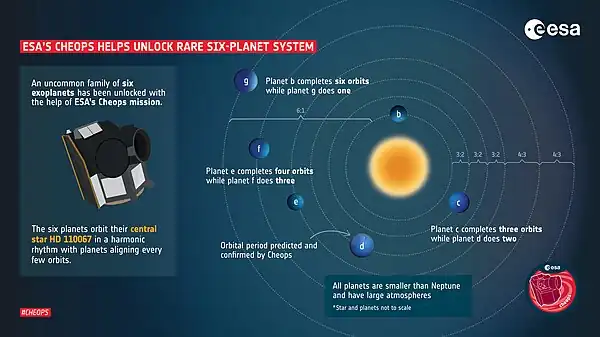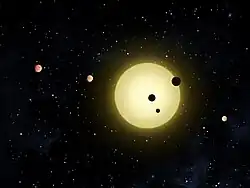| Observation data Epoch J2000 Equinox J2000 | |
|---|---|
| Constellation | Coma Berenices |
| Right ascension | 12h 39m 21.50369s[1] |
| Declination | +20° 01′ 40.0360″[1] |
| Apparent magnitude (V) | 8.43[2] |
| Characteristics | |
| Evolutionary stage | Main sequence |
| Spectral type | K0V[2] |
| Astrometry | |
| Radial velocity (Rv) | −8.56±0.13[1] km/s |
| Proper motion (μ) | RA: -81.703 mas/yr[1] Dec.: -104.532 mas/yr[1] |
| Parallax (π) | 31.0369 ± 0.0222 mas[1] |
| Distance | 105.09 ± 0.08 ly (32.22 ± 0.02 pc) |
| Details[3] | |
| Mass | 0.798±0.042 M☉ |
| Radius | 0.788±0.008 R☉ |
| Surface gravity (log g) | 4.54±0.03 cgs |
| Temperature | 5266±64 K |
| Metallicity [Fe/H] | −0.20±0.04 dex |
| Rotational velocity (v sin i) | 2.5±1.0 km/s |
| Age | 8.1±4.0 Gyr |
| Other designations | |
| Database references | |
| SIMBAD | data |
| Exoplanet Archive | data |
| Extrasolar Planets Encyclopaedia | data |
HD 110067 is a star with six known sub-Neptune exoplanets (b, c, d, e, f, g) with radii ranging from 1.94R⊕ to 2.85R⊕. The planets orbit the host star in a rhythmic orbital resonance. The star, and related planetary system, is located 100 light years away in the constellation Coma Berenices.[3][4][5][6][7][8][9][10]
Description
HD 110067, located 100 light years away in the constellation Coma Berenices, is orbited by six known sub-Neptune exoplanets (b, c, d, e, f, g) with radii ranging from 1.94R⊕ to 2.85R⊕, and with densities (and solid cores) similar to that of gas giants in our own solar system. None of the planets in the planetary system were found to be in the habitable zone for life as we know it.[8]
Discovery
The two innermost exoplanets orbiting HD 110067, a bright K0-type star, were first detected by the TESS (NASA) space telescope, using the transit method, in 2020. The remaining four exoplanets were later confirmed in 2023 on the basis of additional observations using the CHEOPS (European Space Agency) space telescope.[9]
Planetary system

Six known sub-Neptune exoplanets (b, c, d, e, f, g) with radii ranging from 1.94R⊕ to 2.85R⊕ orbit the HD 110067 host star. The star, and related planetary system, is located 100 light years away in the constellation Coma Berenices. Masses of all six of the planets in the system range from 3.9 times to 8.5 times the mass of Earth. All of the planetary orbits in the HD 110067 system are within the orbital distance of the planet Mercury to the sun in our own solar system.[3][4]
The planets orbit the host star in synchronized rhythms of orbital resonance (a rare 1 percent of such systems in the Milky Way galaxy have this symmetry): the innermost planet orbits three times for every two times for the next planet out - a so-called 3/2 resonance; this same 3/2 resonance also applies to the second and third planet, as well as to the third and fourth planet; whereas the penultimate fifth outermost planet orbits four times for every three times twice over for the sixth planet out - in a so-called 4/3 resonance. In addition, the innermost planet completes six orbits in precisely the time the outermost completes one.[3][4][5][6][7][8][9][10]
The resonance ratio for the entire system is 54:36:24:16:12:9.[3][4] The resonance period is ~492 D⊕ (Earth-days).
| Companion (in order from star) |
Mass | Semimajor axis (AU) |
Orbital period (days) |
Eccentricity | Inclination | Radius |
|---|---|---|---|---|---|---|
| b | 5.69+1.78 −1.82 M🜨 |
0.0793±0.00096 | 9.113678(10) | — | 89.061±0.099° | 2.200±0.030 R🜨 |
| c | < 6.3 M🜨 | 0.1039±0.0013 | 13.673694(24) | — | 89.687±0.163° | 2.388±0.036 R🜨 |
| d | 8.52+3.31 −3.25 M🜨 |
0.1362±0.0017 | 20.519617(40) | — | 89.248±0.046° | 2.852±0.039 R🜨 |
| e | < 3.9 M🜨 | 0.1785±0.0022 | 30.793091(12) | — | 89.867±0.089° | 1.940±0.040 R🜨 |
| f | 5.04+1.89 −1.94 M🜨 |
0.2163±0.0026 | 41.05854(10) | — | 89.673±0.046° | 2.601±0.042 R🜨 |
| g | < 8.4 M🜨 | 0.2621±0.0032 | 54.76992(20) | — | 89.729±0.073° | 2.607±0.052 R🜨 |
Scientific importance
On 29 November 2023, an international team of astronomers, led by Rafael Luque, astronomer from the University of Chicago, published a review of the discovery in the journal Nature entitled, "A resonant sextuplet of sub-Neptunes transiting the bright star HD 110067". According to Luque, "It’s like looking at a fossil. The orbits of the planets today are the same as they were a billion years ago."[9]
Further study of the HD 110067 planetary system may provide a better understanding of how the pattern of the planetary orbits in our own solar system arose, which once may have begun harmoniously, but later turned chaotic. The result, possibly, of a passing star or planet or some other astronomical object capable of disrupting the nascent harmonic orbital dynamics. Additionally, further studies of the system, including compositional studies of the planetary interiors and atmospheres, may also provide a better understanding of the conditions that potentially may support life.[9]
See also
- HD 10180, star with six known planets
- Kepler-11, star with six Neptune-like&sub planets
- LHS 1140, star with a system of planets having an atmosphere
- List of potentially habitable exoplanets
- TRAPPIST-1, a star with a similarly long resonant chain of Earth-sized planets.
- LP 890-9, second known coolest star with planets
- Six-planet resonance
- Tabby's Star, star with notable transit data
References
- 1 2 3 4 5 6 Vallenari, A.; et al. (Gaia collaboration) (2023). "Gaia Data Release 3. Summary of the content and survey properties". Astronomy and Astrophysics. 674: A1. arXiv:2208.00211. Bibcode:2023A&A...674A...1G. doi:10.1051/0004-6361/202243940. S2CID 244398875. Gaia DR3 record for this source at VizieR.
- 1 2 3 "HD 110067". SIMBAD. Centre de données astronomiques de Strasbourg. Retrieved 1 December 2023.
- 1 2 3 4 5 6 Luque, R.; Osborn, H. P.; et al. (29 November 2023). "A resonant sextuplet of sub-Neptunes transiting the bright star HD 110067". Nature. 623: 932–937. arXiv:2311.17775. doi:10.1038/s41586-023-06692-3.
- 1 2 3 4 Clery, Daniel (19 November 2023). "Astronomers stunned by six-planet system frozen in time - Undisturbed family of "sub-Neptunes" in rhythmic orbits could hold clues to planet formation". Science. doi:10.1126/science.ze93fui. Archived from the original on 19 November 2023. Retrieved 19 November 2023.
- 1 2 Brennan, Pat (29 November 2023). "Discovery Alert: Watch the Synchronized Dance of a 6-Planet System". NASA. Archived from the original on 29 November 2023. Retrieved 29 November 2023.
- 1 2 Kathunur, Sharmila (30 November 2023). "Six-Planet System in Perfect Harmony Shocks Scientists - Six "sub-Neptune" worlds locked in a delicate dance around a nearby star offer fresh insights for the orbital evolution of planetary systems". Scientific American. Archived from the original on 30 November 2023. Retrieved 30 November 2023.
- 1 2 Klesman, Alison (29 November 2023). "'Shocked and delighted': Astronomers find six planets orbiting in resonance - Orbiting the brightest star ever found to host more than four planets, all have rocky or icy cores and extended atmosphere". Astronomy. Archived from the original on 29 November 2023. Retrieved 29 November 2023.
- 1 2 3 Dunn, Marcia (29 November 2023). "NASA satellites discovered a 6-planet solar system in perfect synchrony". PBS. Archived from the original on 30 November 2023. Retrieved 30 November 2023.
- 1 2 3 4 5 Miller, Katrina (29 November 2023). "A Star With Six Planets That Orbit Perfectly in Sync - One hundred light years away, a handful of planets are circling a star in the same configuration as when they formed". The New York Times. Archived from the original on 29 November 2023. Retrieved 30 November 2023.
- 1 2 Ghosh, Pallab (29 November 2023). "'Perfect solar system' found in search for alien life". BBC. Archived from the original on 29 November 2023. Retrieved 29 November 2023.
- ↑ Lazaro, Enrico de (30 November 2023). "Astronomers Discover Resonant System of Six Sub-Neptune Exoplanets around HD 110067 - The bright nearby star HD 110067 hosts six transiting sub-Neptunes that follow a chain of resonant orbits, according to new research led by University of Chicago astronomers". Science News. Archived from the original on 2 December 2023. Retrieved 2 December 2023.
Further reading
- The nature and origins of sub-Neptune size planets, Jacob L. Bean, Sean N. Raymond, James E. Owen, 22 Oct 2020

.png.webp)
